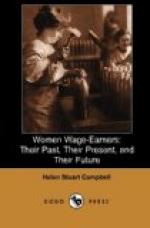Other women oversaw the curing of the fish; but there is no record of the wage beyond the general one which for the earliest days of the colony gives rates for women as from four to eight pence a day without food. These rates followed almost literally those of England at that time. Half of the day’s earnings were accounted an equivalent for diet, and contractors for feeding gangs in agriculture, among sailors, or wherever the system was adopted, allowed seven and one-half pence per day a head for men and women alike. Women servants received ten shillings a year wages, and an allowance of four shillings additional for clothing. The working day still remained as fixed by the law late in the fifteenth century,—from five A.M. to eight P.M., from March to September, with half an hour for breakfast, and an hour and a half for dinner.
These rates gradually altered, but for women hardly at all, the wages during the eighteenth century ranging from four to six pounds a year. The colony, however, gave opportunities unknown to the mother country, and gardening and the cultivation of small vegetables seem to have fallen much into the hands of women.[9] They had studied the best methods for hotbeds, and grew early vegetables in these, the first record of this being in 1759.
Gloves were by this time made at home, buttons covered, and many small industries conducted, all connected with the manufacture and making up of clothing. Patriotic spinning occupied many; and the “Boston News-Letter” has it that often seventy linen-wheels were employed at one gathering. The agitation caused by the Stamp Act turned the attention of all women to the production of cloth as a domestic business. Worcester, Mass., in 1780 formed an association for the spinning and weaving of cotton, and a jenny was bought by subscription.[10]
Prices by this time had risen, and in 1776 the Andover records mention that a Miss Holt was paid eighteen shillings for spinning seventy-two skeins, and seven shillings eleven pence for weaving nineteen yards of cloth. Women generally could spin two skeins of linen yarn a day; but there is record of one, a Miss Eleanor Fry of East Greenwich, R.I., who spun seven skeins and one knot in one day,—an amount sufficient to make twelve large lawn handkerchiefs such as were then imported from England.
Within four years another Rhode Island family of Newport are recorded in 1768 as having “manufactured nine hundred and eighty yards of woolen cloth, besides two coverlids (coverlets), and two bed-ticks, and all the stocking yarn of the family.”
The Council of East Greenwich fixed prices at that time at rates which seem purely arbitrary and are certainly incomprehensible. Thus for spinning linen or worsted, five or six skeins to the pound, the price was not to exceed sixpence per skein of fifteen knots, with finer work in proportion. Carded woollen yarn was the same per skein. Weaving plain flannel or tow or linen brought fivepence per yard; common worsted and linen, one penny a yard; and other linens in like proportion.[11]




